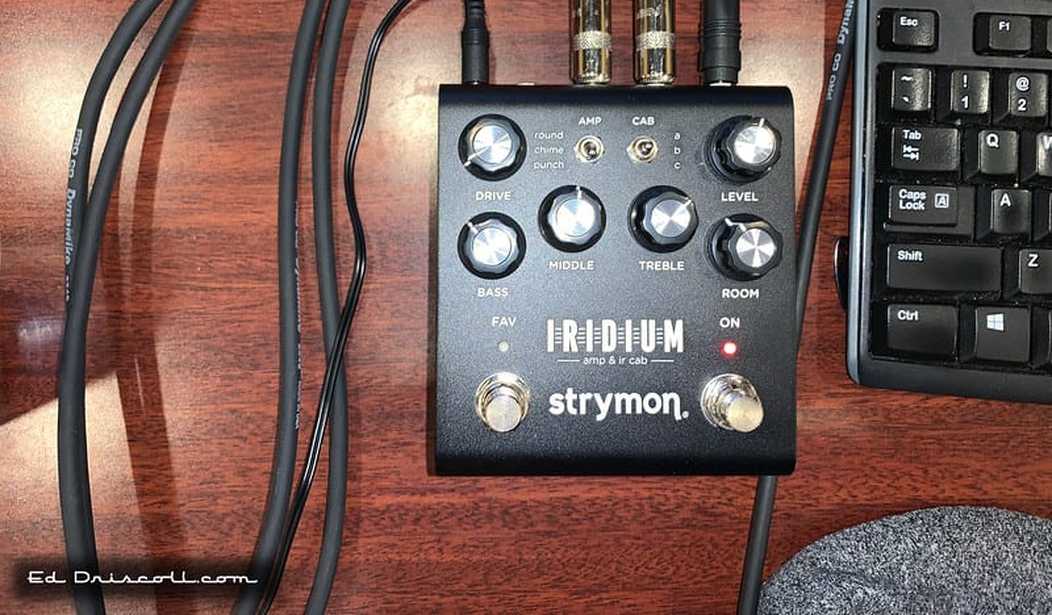Since the 1960s, there has often been a disparity when it comes to how we perceive the electric guitar sounds we hear on a record, and how they were recorded. From the exploding Hindenburg on the front cover of Led Zeppelin I to the sonic bombast within its grooves, most listeners imagine that Jimmy Page was roaring away on at least one 100-watt Marshall amplifier and a giant stack of speakers dialed up to 11. In reality, Page, a crafty recording studio vet by the ripe old age of 24, used a small Supro amp, with about 18-watts of power, and very carefully positioned the microphones around it. It’s an audio illusion: a small amp cranked up very loudly, micced correctly will often sound much more powerful than a 100 watt amplifier trapped in the confined quarters of a recording studio.
By the 1970s, it was no longer even necessary to plug into a guitar amp to get great sounds. On 1971’s Led Zeppelin IV, Page’s iconic “Black Dog” riff was recorded by engineer Andy Johns by sending Page’s Les Paul electric guitar into a preamp on the Helios mixing board in London’s Island Studios. The following decade, Tom Scholz, the musical and engineering genius behind Boston’s best-selling albums, designed a small plastic box, only slightly larger than Sony’s then-ubiquitous Walkman cassette players, and crammed it full of integrated circuits, which he dubbed the Rockman. The Rockman had a smooth high-tech guitar sound that was extremely popular in the 1980s. It could be heard on numerous hit records, and it made for easy recording of electric guitar sounds free of the hassle of complaining neighbors in thousands of home project studios – including mine.
But the Rockman was sort of a two-trick pony, capable of one nice glassy clean guitar sound, and one great roaring (albeit heavily processed-sounding) distorted guitar sound. By the 1990s, advancements in technology allowed guitar and amp modeling products to reproduce a plethora of classic sounds, to varying degrees of success. In 1995, Roland released their VG-8 guitar modeling system (later replaced by Roland’s long-selling VG-88 and stillborn VG-99 versions) and in 1998, Line6 released their first Pod, which initially provided 16 simulated amp models and 16 effects. Regarding the Roland VG-8 and other amp and guitar modeling devices, as David Bowie’s longtime producer Tony Visconti was quoted in the 2000 book Behind the Glass, “Ten years ago, all these effects were very cheesy. But now they’re so good, they sound so convincing. If you’re going to solo it, you might smell a rat, but in a mix, who’s going to know?”
Even more so, twenty years later. in 2012, Kemper released their Profiling Amplifier, and Line 6 followed suit by releasing their Helix rig in 2015. However, these are both complex and expensive products, retailing at $1800 and $1500, respectively.
Enter the Iridium
Last year, Strymon released their Iridium amp and speaker cabinet modeling pedal, which unlike the Kemper and Helix, doesn’t attempt to be all amps to all men. The Iridium (nice name, considering the New York club with the same name was the longtime haunt of electric guitar pioneer Les Paul), simply models three classic amps. To avoid copyright infringement, Strymon call these the Round, Chime, and Punch models, which are based on the classic Fender Twin, Vox AC-30, and the Marshall Plexi, respectively. Each amp can also have a choice of three different speaker cabinets, which provide dramatically different tones, and the speaker cabinet simulation can be bypassed as well, which is handy if you’re plugging the Iridium into an actual guitar amp:
Deluxe Reverb 1×12″ by OwnHammer
Impulse of a vintage Fender Deluxe Reverb 1×12″ open back combo with a 1978 Fender CTS ceramic 12″ speaker.Blues Junior 1×12″ by cabIR
Impulse of a 1×12″ Blues Junior cabinet with a Jensen C12N speaker.Vibrolux 2×10″ by cabIR
Impulse of a 1965 Fender Vibrolux 2×10″ with Jensen C10NS speakers.AC30 2×12″ AlNiCo by OwnHammer
Impulse of a Vox AC30/6 open back 2×12″ combo with 2001 Celestion T0530 Blue AlNiCo speakers.1×12″ AlNiCo by Celestion
Impulse of a Celestion Blue AlNiCo speaker in a closed back 1×12″ cab.Mesa 4×12″ by Valhallir
Impulse of a 4×12″ Mesa Boogie halfback with two Celestion Black Shadow MC-90 and two ElectroVoice Black Shadow EVM12-L speakers.GNR 4×12″ by OwnHammer
Impulse of a 1971 Marshall 1960B “basketweave” 4×12″ cabinet with 1971 Celestion T1221 G12M-25 speakers.2×12″ Vintage 30 by Celestion
Impulse of a Celestion Vintage 30 in an open back 2×12″ cab.Marshall 8×12″ AlNiCo by cabIR
Impulse of a 1965 Marshall 8×12″ re-issue full stack cabinet, with Celestion T652 AlNiCo speakers.
The cabinet models can be customized as well, as Paul White notes in his March Sound on Sound review:
A high-quality cabinet model is really important to getting a modeled amplifier to sound and feel authentic. Impulse responses have been used since the early days of the Line 6 Pod, of course, but Strymon have taken a high-resolution approach here, using 500 millisecond, 24-bit, 96kHz IRs — and rather than reinvent the wheel by creating their own speaker IRs, Strymon have populated this pedal with quality ones from OwnHammer, Celestion, cabIR and Valhallir. A mini-USB port caters for loading your own impulse responses from a computer — it’s a simple drag-and-drop procedure once you’ve downloaded the free Mac/Windows Impulse Manager software — but note that only 24-bit, 96kHz IRs can be loaded. The software also allows you to make the most of the stereo output by loading different IRs into the left and right channels; I tried this with some of the IRs in my collection and it worked flawlessly, providing some useful tonal alternatives.
The chaps on the popular YouTube series That Pedal Show have devoted several segments to what they call “pedal platform amps.” The idea is to set up a guitar amp with a fairly neutral setting, and shape its tone with your various effects pedals. For recording direct into the audio interface or mixing board, the Iridium is a sort of “pedal platform stompbox”; while its Drive control can generate a certain amount of grit, it’s really designed to driven harder via your favorite fuzz and drive pedals. Dan and Mick of That Pedal Show were pretty keen on the Iridium late last year, which helped influence my decision to buy one:
I purchased my Iridium in December, because the previous year, I purchased one of the first Eventide H9000 Harmonizers. (Incidentally, until recently, my early review of the H9000 for PJ Media was the only outside product review of the unit on the Eventide Website, until Sound on Sound finally published their review in June of last year.) The H9000 is an incredibly versatile unit, but many of its guitar-based effects were ported over from their best-selling H9 floor pedal for guitarists, and are designed to be plugged into an amp for their best sound. Or an amp-modeling device like the aforementioned Kemper and Helix — but having taken a deep dive into learning the H9000, I didn’t desire the added cost or learning curve. When I watched demo clips of the Iridium in action, it seemed like the perfect fit for what I was looking for, both in terms of affordability and ease of getting started.
What helps sell the Iridium as a “real” amp in a record mix is its high quality digitally modeled room sound, which is adjustable from a small to medium to a large room sound by first pressing and holding the right “On” footswitch until the LED lights above it flash, and then turning the room knob above it from left to right to increase the simulated room size, and then pressing the On footswitch one more time. Otherwise, the Room dial acts as a control to blend in the amount of room in the mix. If you’re using the Iridium on a recording, for most applications, you’ll probably want to keep the room sound dialed back a bit, rather than commit to something that could be too muddy and distant when all the instruments are added, particularly if you’ll be adding a digital reverb at mixdown to blend everything together. But a bit of room sound really does make the Iridium sound like a micced amp in a room, rather than the dry in-your-face sound of an amp alone.
There are several ways of getting a guitar signal into the Strymon Iridium. The first is simply plugging an electric guitar into the rear of the Iridium with a ¼” guitar cable. I wanted my guitar to first go through the Eventide H9000 to the Iridium, so I used a Radial Engineering J-48 Direct Injection box, which was powered by a Rolls Phantom Power supply into the H9000, which I then input into the Iridium via a pair of XLR to ¼-inch plugs cables. The Iridium will accept a stereo input, provided you use a stereo TRS adapter cable.
For those who prefer to record guitars direct, to keep their production options flexible for as long as possible, it’s also possible to use the Iridium as a re-amping tool, by outputting the signal from your DAW, and then plugging that into the Iridium, or first into an effects pedal or box like the H9 or H9000. Whether it’s a solo or rhythm passage, putting a DI-ed guitar part recorded in a DAW on loop and flipping through the Iridium’s three amp models, and each of amp’s choice of three speaker cabinet models will yield dramatically different results, even before any additional effects are added.
In addition to its role as the final stage in a guitar re-amping product in the project studio, with its miniplug input for pair of stereo headphones, the Iridium provides a very big welcoming sound for practice sessions. It’s a great practice tool for the guitarist who wants to keep his chops in shape, without disturbing his neighbors with a roaring amplifier.
So how does it sound? I think the Strymon Iridium really nails the tones of the three iconic amps built into the unit. With the treble cranked up, I did notice a bit of hiss during quieter and silent passages, but then, the amps the Iridium recreates would have their share of hiss as well. And these days, hiss is easy to reduce or eliminate via an EQ plug-in, a noise gate plug-in, or with audio repair software such as Izotope’s brilliant RX7.
A couple of real-world examples:
On this song, “The Rain Falls Hardest at Night,” the rhythm guitar is a 1998 Fender Nashville Telecaster run through the H9000’s Clean Preamp and Vintage Delay patches, into the Iridium on its “Chime” amp (its Vox AC-30 simulation) through the Celestion Blue Alnico speaker recreation, and a bit of the small room setting. The lead guitar is a 2000 Gibson Historic Sunburst 1959 Les Paul reissue through the H9000’s Crush Station fuzz patch, and Tape Echo delay, into the Iridium’s Punch (its Marshall “Plexi” simulation into a 2×12″ Vintage 30 Celestion speaker cabinet model, again with a pinch of room tone.)
On the next song, “Love Can Turn,” the left channel has a 1984 Fender 1957 Stratocaster reissue through the H9000 Crush Station and compressor is in the Iridium’s Punch Mode and its recreation of a 1965 Marshall 8×12″ re-issue full stack cabinet. The right channel has the aforementioned 2000 Gibson Les Paul reissue through the same rig. The guitar solo has the H9000 Crush Station and a bit of Eventide’s recreation of Roland’s Dimension D chorus effect to take the treble off a bit, into the Marshall Plexi simulation and 2×12″ Vintage 30 Celestion speaker cabinet model.
The Strymon Iridium solves many problems for the guitarist recording at home, or playing in a live situation such as a church gig, or a club where the front of house engineer would prefer better control of the sound. Highly recommended.











Join the conversation as a VIP Member